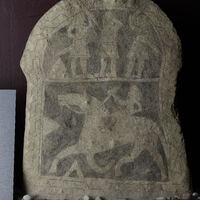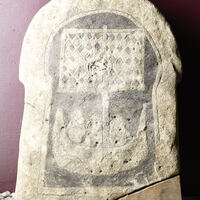GP 13 Alva Bopparve














mer grejer




0.0
| Plane | Position | Flip |
| Show planes | Show edges |
Parish Find Location Alva
Find Location On a property called ʻBopparveʼ in Alva parish, owned by Alva prästgården.
Find Context Classification Private Property
Present Location Classification Gotlands Museum Fornsalen
Coordinate Present Location (lat) 6393355
Coordinate Present Location (long) 696536
Material Sandstone
Limestone Type crinoid limestone
Geological Group Hemse Group (40%)
Height 74
Width 47
Thickness 4-8
Lindqvist Type B (ca. 500-700)C/D (ca. 700-1000)
Lindqvist Shape Dwarf stone
Context and Discovery According to Lindqvistʼs brief report (1962, p. 17), the stone was discovered by the farmer Tryggve Stumle from Alva around 10 m east of a farm road between St. Kruse and Änge in Alva parish, on a property called ʻBopparveʼ, and donated to Gotlands Museum in 1958. ʻBopparveʼ is a field name, not a name of a farmstead. The land is owned by Alva prästgården.
Measurements, Material and Condition Remarkably, the picture stone is made of sandstone, which is of poor quality (Lindqvist 1962, p. 17). The thickness of the slab is 6–8 cm at the bottom and about 4 cm at the top. The width of the monument is 47 cm both between the corners of the head and at the stone’s base. Its height is 59 cm between the lower edge of the image field and the top of the stone, and 74 cm including the preserved left-hand corner of the root. Most of the root as well as a very small part of lower right-hand corner of the image field are broken off. The obverse has many natural pits and grime, and shows traces of weathering (ibid.). However, most of the bas-relief carvings are still discernible.
Description of Ornament and Images The carvings have been traced with paint and described by Lindqvist (1962, p. 17–19). Remains of the border decoration, which is 6–8 cm wide, are partly discernable, however, Lindqvist did not dare to reconstruct it. The image field depicts a sailing ship with towering stems and a slightly curved keel line. The ship’s hull is filling the lower half of the stone, while the sail is placed in the head field of the stone. The rectangular, framed sail features a rhombic pattern with carved and raised fields alternating. Three crewmen with round shields are placed on board of the vessel. The man right of the mast lacks clear contours, but the profiles of the other two men, left of the mast, with long hair and profiled faces, are quite clear.
Interpretation of the Imagery No interpretation
Type and Dating Lindqvist (1962, p. 17) regards the dwarf stone as an ʻAbschnitt Cʼ monument, dating it to around AD 700. In Jan Peder Lamm’s list, however, it is labelled as Middle Type (Type B) picture stone, which suggests a date of AD 500 to 700 (which is adopted by Guber 2011, pp. 50, 110), while in the text of the same book written by Erik Nylén, it is dated to AD 700 to 800 (Lamm/Nylén 2003, pp. 137, 180). Varenius (1992, p. 63, appendix 2) assigns the ship depiction on the Bopparve stone to his group 2 (enkel rigg), which he dates to the period between the 7th and the 9th century. According to Imer (2004, pp. 97–98, 104), the stone must be dated earlier than other Type C/D stones, presumably to the early 8th century.
Oehrl regards the stone (as well as GP 79 Etelhem Järnvägslinje) as a late Type B stone, perhaps representing a transitional form between the groups of middle and late type picture stones, presumably dated to the 8th century or even later (2019a, pp. 11, 18, 227). However, the only features in common with Type B are the small size of the stone and the lack of separation of the image field. There is hardly any reason to categorize mushroom-shaped stones as other than Type C/D stones, as they feature typical Late Type imagery and can thus be dated to the 8th to 10th centuries.  GP 79 Etelhem Järnvägslinje
GP 79 Etelhem Järnvägslinje
References Lindqvist 1962, pp. 17–19, fig. 9; Lamm/Nylén 2003, p. 136–137; Imer 2004, pp. 97–98, 104, fig. 3; Guber 2011, pp. 50, 110 cat. no. 1; Oehrl 2019a, pp. 11, 18, 227–228, 231, pls. 2i, 275b.
Bildstenen påträffades på ägan Bopparve, som tillhör Alva prästgård. Stenen donerades till Gotlands museum 1958 av upphittaren.
Nuvarande lokalisering
Utställd i Bildstenshallen på Gotlands museum.
Beskrivning
En dvärgsten av sandsten (sen period B), 59 cm hög och största bredd 47 cm. Stenen är väderbiten, men ett skepp med segel och tre besättningsmän med runda sköldar kan urskiljas, liksom spår av kantdekor.
Stor svampformig bildsten (period CD), 3,25 m hög och största bredd 1,75 m. På nedre delen av bildstenen vågor, ett stort skepp med segel, en stående besättning med sköldar och spjut stående i aktern. Under styråran en symbol med tre trianglar.
Inskrift
Ingen inskrift
Datering
Kan inte dateras med säkerhet, tillhör övergångsperioden B-C/D, troligen från 700-talet, kanske senare.
Tolkning
Ingen tolkning.
AA
TitleGP 13 Alva Bopparve
Gotlands Museum ID GFC10126
Jan Peder Lamm ID 9
Last modified Aug 25, 2025


